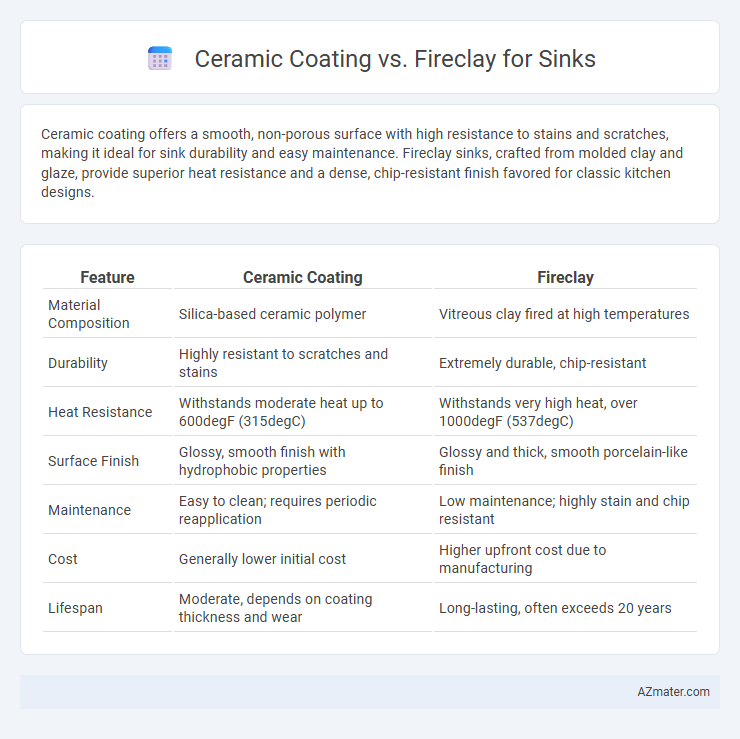Ceramic coating offers a smooth, non-porous surface with high resistance to stains and scratches, making it ideal for sink durability and easy maintenance. Fireclay sinks, crafted from molded clay and glaze, provide superior heat resistance and a dense, chip-resistant finish favored for classic kitchen designs.
Table of Comparison
| Feature | Ceramic Coating | Fireclay |
|---|---|---|
| Material Composition | Silica-based ceramic polymer | Vitreous clay fired at high temperatures |
| Durability | Highly resistant to scratches and stains | Extremely durable, chip-resistant |
| Heat Resistance | Withstands moderate heat up to 600degF (315degC) | Withstands very high heat, over 1000degF (537degC) |
| Surface Finish | Glossy, smooth finish with hydrophobic properties | Glossy and thick, smooth porcelain-like finish |
| Maintenance | Easy to clean; requires periodic reapplication | Low maintenance; highly stain and chip resistant |
| Cost | Generally lower initial cost | Higher upfront cost due to manufacturing |
| Lifespan | Moderate, depends on coating thickness and wear | Long-lasting, often exceeds 20 years |
Introduction: Comparing Ceramic Coating and Fireclay Sinks
Ceramic coating sinks feature a durable, smooth surface resistant to stains and scratches, offering easy maintenance and a sleek appearance. Fireclay sinks are made from molded clay fired at high temperatures, providing exceptional toughness, chip resistance, and a classic, glossy finish. Both materials excel in durability and aesthetic appeal, but fireclay is often preferred for its traditional look and superior resistance to heat and impacts.
Material Composition: Ceramic Coating vs Fireclay
Ceramic coating for sinks consists of a polymer-based layer fused onto the surface, enhancing resistance to stains, scratches, and heat by forming a durable protective barrier. Fireclay sinks are crafted from a natural mixture of clay and minerals, fired at extremely high temperatures to create a dense, vitrified, and non-porous material renowned for its toughness and smooth, glossy finish. The key difference lies in ceramic coating being a surface treatment applied after manufacturing, whereas fireclay is a bulk material integral to the sink's structure, offering superior chip resistance and longevity.
Durability and Strength: Which Sink Lasts Longer?
Ceramic coating sinks offer a durable, scratch-resistant surface but are prone to chipping under heavy impact, whereas fireclay sinks are known for exceptional strength, withstanding heat and heavy use without cracking. Fireclay's non-porous, glazed surface enhances longevity by resisting stains and daily wear, making it more resilient compared to ceramic-coated alternatives. When it comes to lasting durability and strength, fireclay sinks generally outlast ceramic-coated sinks, providing a robust option for long-term kitchen use.
Scratch and Stain Resistance: Performance in Daily Use
Ceramic coating sinks exhibit superior scratch resistance due to their hard, glass-like surface, making them highly durable against daily abrasions and impacts. Fireclay sinks, made from vitrified clay, offer exceptional stain resistance as their non-porous surface prevents absorption of liquids and discoloration. In daily use, ceramic coating excels in maintaining a scratch-free appearance, while fireclay ensures long-lasting stain protection and easy cleaning.
Aesthetic Appeal: Design and Color Options
Ceramic coating offers a smooth, glossy finish with vibrant color options that enhance modern kitchen aesthetics, providing high resistance to stains and scratches. Fireclay sinks boast a classic, timeless appeal with a matte or satin surface and a range of neutral tones that complement rustic or traditional designs. Both materials support customization, but ceramic coating allows for more diverse and bold color palettes, while fireclay prioritizes durability with subtle, elegant hues.
Maintenance and Cleaning Requirements
Ceramic-coated sinks offer a smooth, non-porous surface that resists stains and scratches, making routine cleaning with mild detergents quick and effortless. Fireclay sinks, crafted from tempered clay and glaze, require gentle cleaning to avoid chipping and discoloration, as harsh abrasives can damage their glossy finish. Both materials benefit from regular wiping, but ceramic coatings generally demand less maintenance to preserve their pristine appearance over time.
Cost Comparison: Ceramic Coating vs Fireclay
Ceramic coating offers an affordable sink protection solution with prices typically ranging from $50 to $150 per application, making it cost-effective for extending sink durability. Fireclay sinks, however, involve higher upfront costs between $500 and $1,000, reflecting their durable, heavy-duty construction and aesthetic appeal. When comparing long-term value, ceramic coating requires periodic reapplication but reduces surface damage expenses, whereas fireclay sinks demand minimal maintenance but represent a larger initial investment.
Installation Differences and Considerations
Ceramic coating sinks offer a sleek, smooth finish applied through spraying and curing processes, requiring professional installation to ensure even coverage and durability. Fireclay sinks are typically handcrafted from molded clay, necessitating careful handling and precise fitting during installation due to their heavy weight and brittleness. The choice between them also depends on your kitchen setup, as fireclay sinks may need reinforced countertops for support, while ceramic coating sinks are compatible with standard mounting methods.
Environmental Impact and Sustainability
Ceramic coating sinks typically use inorganic materials that offer high durability and resistance to chemicals, reducing the frequency of replacements and minimizing waste. Fireclay sinks are made from natural clay fired at ultra-high temperatures, making them biodegradable and non-toxic but energy-intensive to produce. Both materials provide sustainable options, with fireclay excelling in biodegradability and ceramic coatings contributing to extended sink lifespan through enhanced surface protection.
Final Verdict: Choosing the Best Sink Material for Your Needs
Ceramic coating offers a smooth, durable finish resistant to stains and scratches, ideal for users prioritizing easy maintenance and aesthetic appeal. Fireclay sinks provide exceptional toughness and chip resistance due to their high-temperature fired clay composition, making them perfect for heavy daily use in busy kitchens. Choosing between ceramic coating and fireclay depends on whether durability or surface finish is more critical for your sink's performance and longevity.

Infographic: Ceramic coating vs Fireclay for Sink
 azmater.com
azmater.com